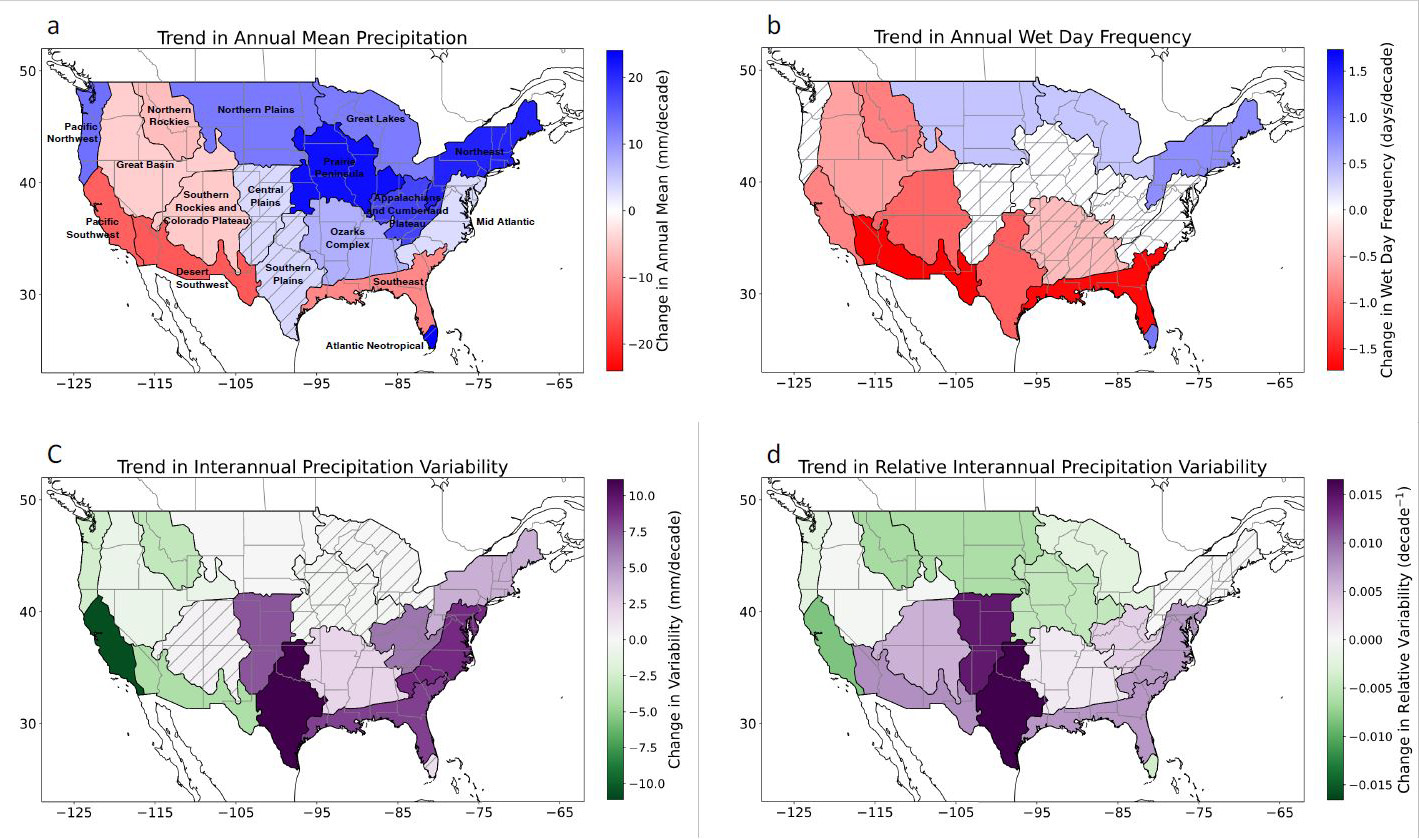Science for a Changing Climate
Trienens Institute Faculty Affiliate Daniel E. Horton studies the intersection of climate change and public health, Northwestern Magazine recounts how his recent work is shaping the future of environmental policy
New research tracks precipitation variability across regions of the United States
Consistent rainfall is a vital piece of Earth’s ceaselessly flowing water cycle.
New research from Northwestern University tracks the year-over-year regularity of rainfall levels across the US, an issue altering the outlook for agriculture and water resource management as well as impacting the wellbeing of ecosystems and wildlife.
While existing climate models anticipate increasingly irregular weather as a part of human-caused climate change, the study is the first to trace rainfall variability that is already observable across the contiguous United States.
The study, “Observed Changes in Interannual Precipitation Variability in the United States” was published in Geographical Research Letters earlier this month.
“Variability is important because two places could be getting the same amount of precipitation over time, but that rain could be distributed completely differently. For example, it’s much easier to plan around 100 inches of rain if that 100 inches comes every year than it is to plan around wildly fluctuating annual rainfall—150 inches of rain one year and 50 inches the next year—even though it’s the exact same annual average,” said Ryan Harp, the paper’s lead author.
Harp was a Postdoctoral Research Fellow with the Ubben Program for Climate and Carbon Science at the Paula M. Trienens Institute for Sustainability and Energy when the research was conducted. Senior author Daniel E. Horton is an assistant professor of Earth and Planetary Sciences in Northwestern’s Weinberg College of Arts and Sciences, where he also leads the Climate Change Research Group.
Horton and Harp used direct observations of precipitation to detect changes in 17 distinct regions in the US. Each region has its own set of ecological factors like temperature and topography that shape its precipitation patterns. The study focused on four precipitation metrics: annual average precipitation, annual precipitation frequency, and two forms of interannual precipitation variability within each region.
The study found that for most of the eastern US, average annual rainfall is increasing as are the number of wet days; the opposite is true for the western US, where precipitation variability is decreasing. In southeastern regions, rain is becoming more variable—less consistent—from year to year with fewer wet days on average. North-central and Rocky Mountain regions are observing mixed patterns of variability change.

Consistent levels of rainfall are particularly important for the agricultural sector, for one, for consistent crop yield and quality. In the long run, inconsistent precipitation may lead to erratic yields of critical agricultural resources.
Irregular rainfall also poses challenges for water resource management like for construction of hydroelectric dams or Great Lakes water levels. “A lot of engineering and infrastructure design is based on the climate we’re used to. It’s important to recognize that the climate is already changing and to keep that factor in mind as we’re designing new infrastructure,” said Harp.
More broadly, the stability of ecological systems is at risk. “Animals and plants are impacted by precipitation variability; their ability to live in certain areas is limited by these changes,” said Harp. To the same point, Horton noted that “some species are in decline because of inconsistent availability of water in their habitat and the ecosystems upon which they rely...These are ecological systems that have developed over millennia and have become accustomed to historical precipitation patterns that are now undergoing change.”
In October 2022, Harp and Horton published research focusing on the same 17 US regions to understand how rainfall intensity has changed over the last few decades. They found that not only is it raining more in the US, but it is raining harder. This new study elucidates more emerging systematic shifts in the precipitation system.
Precipitation patterns across the world have shifted due to climate change, partly because rising temperatures increase atmospheric moisture availability. Yet, summary reports like the U.S. National Climate Assessment have not yet included descriptions of observed precipitation variability changes. The researchers hope this research will fill that gap. “There are a number of different ways to characterize changes in precipitation patterns. Both of Ryan’s recent studies seek to more comprehensively detect signals of change in observed precipitation patterns,” said Horton.
Harp and Horton’s two recent observed precipitation-focused studies fall under the detection subfield of climate change detection and attribution. Detection studies seek to identify underlying signals or patterns of change in the climate system, while attribution studies attempt to link the observed patterns of change to physical causes. While Horton and Harp have worked to find the signals, there remains a need to formally illustrate the mechanistic links between precipitation variability change and anthropogenic climate change.
“Ryan’s postdoc support from the Ubben Program provided him with an opportunity to expand his research acumen in new and creative directions,” reflected Horton. “Providing the support and freedom for early career researchers to innovate and fill critical research gaps is immeasurably helpful to the researcher and society at large.”
The paper, “Observed changes in interannual precipitation variability in the United States,” was supported by the Ubben Program for Carbon and Climate Science at Northwestern University. It was published July 6, 2023 in the Geophysical Research Letters.